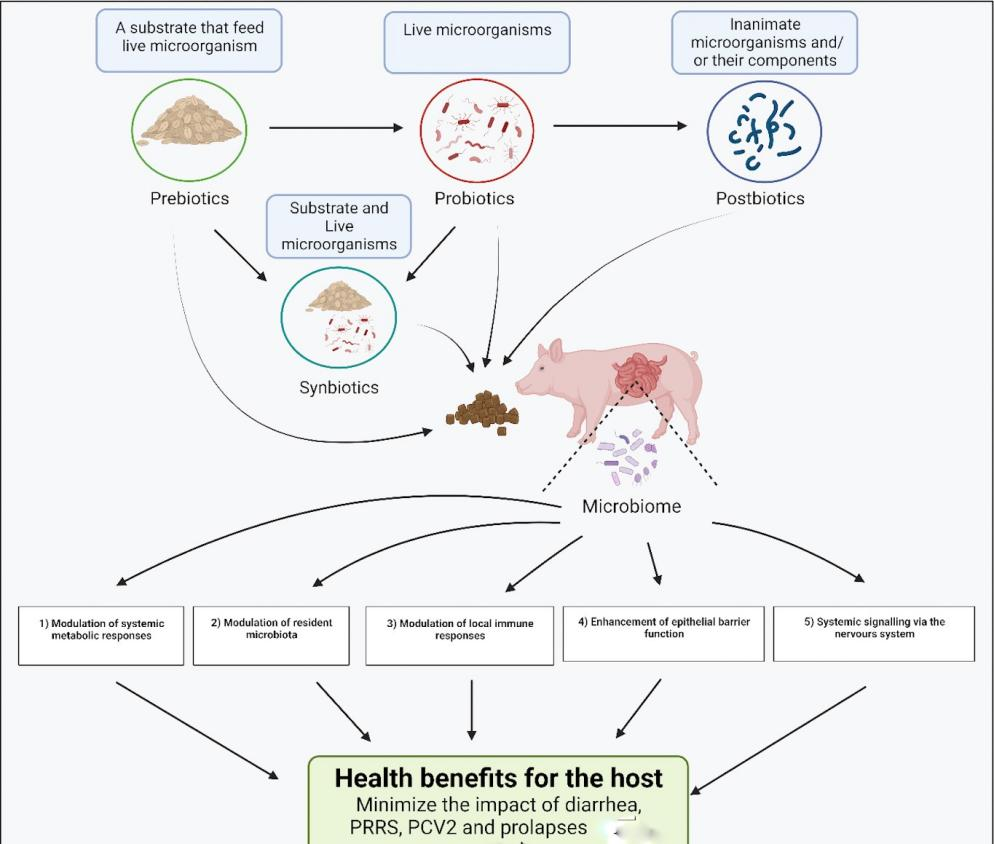Dietary means of influencing the gut microbiome and its metabolic activities, as well as intestinal integrity and digestive health.
The gastrointestinal microbiome plays indispensable roles in modulating immune response and functions of the digestive system. There is growing evidence that the impact of gastrointestinal microbiome extends to other systems such as the reproductive, respiratory, locomotion and nervous system.
A promising area of research focuses on dietary interventions that induce modulation of the gastrointestinal microbiota with the ultimate aim of minimizing the impact of gastrointestinal and respiratory diseases (Niederwerder, 2017; Surendran Nair et al., 2019), decreasing the incidence of pelvic organ prolapses (Kiefer et al., 2021), improving litter pre-weaning survival (Nowland et al., 2021) and supporting post-weaning growth performance.
Along with fermented feeds and fiber, probiotics, prebiotics and postbiotics are dietary means of influencing the gut microbiome and its metabolic activities. However, a lack of definition and understanding of the impact of these product categories can decrease the effectiveness of these interventions.
Prebiotics are non-digestible dietary components usable by beneficial microbes that colonize the intestine, and consequently improve pig health. In other words, prebiotics are food for "good bacteria" which may include Lactobacillus, Bifidobacterium, and other resident microbes (Gibson et al., 2017). Several types of dietary fiber are prebiotics, but not all prebiotics are fiber. Prebiotics can be found – although at low levels – in foods such as oats, whole grains, and high-fiber ingredients.
Increasing the intake of prebiotics may boost the number of good bacteria in the gut and has the potential to promote digestibility of nutrients, support the immune system, improve mineral absorption and affect energy, and amino acid balance of the pig. However, the term "prebiotic" rarely appears on product labels, so it may be difficult to determine whether they are present in a product. Instead, producers should look for the actual names of the prebiotics, such as galacto-oligosaccharides, fructo-oligosaccharides, oligofructose, chicory fiber or inulin in the products of interest.
Probiotics are live microorganisms that can provide health benefits to the pig when added to the diet in adequate amounts (Hill et al., 2014). Not all probiotics are the same and different strains may provide health benefits in diverse ways, as supported by different scientific reports. When choosing a probiotic type, it is important to use a product backed by scientific evidence for the desired health benefits.
Keep in mind that, unlike prebiotics and postbiotics (see below), probiotics need to stay alive to be effective. Therefore, users must follow indications on how to store each probiotic (some may require refrigeration) and assess the risk of inactivation after thermal processing of feed such as pelleting. Probiotic manufacturers should disclose complete taxonomic information about the probiotic (genus, species and strain), the concertation of live probiotic cells, as well as the potency expected through the end of its shelf life. Some examples of common strains used as probiotics in the swine industry are Saccharomyces cerevisiae, Enterococcus faecium and Lactobacillus rhamnosus.

An emerging line of products which have been popular the last few years is postbiotics. Postbiotics are defined as a "preparation of inanimate microorganisms and/or their components that confer a health benefit on the host" (Salminen et al., 2021). New research studies suggest that postbiotics, are responsible for many of the benefits previously associated with probiotics and overall microbiome and digestive health.
Postbiotics are not naturally found on feeds, but derived from a progenitor microorganism grown under specific conditions. Moreover, a postbiotic does not have to be derived from a known probiotic microbe. The final postbiotic must contain inactivated microbial cells and/or metabolites or cell components that have evidence of a health benefit for the pig. Aspergillus oryzae and Lactobacillus acidophilus fermentation extracts are examples of postbiotic products.
Synbiotics represent blends of probiotics and prebiotics. Complementary synbiotics contain a probiotic and a prebiotic with different mechanisms but seek to achieve a common beneficial outcome in the microbiome as a whole (Swanson et al., 2020).
In conclusion, probiotics, prebiotics, synbiotics and postbiotics are dietary means of influencing the gut microbiome and their metabolic activities, as well as intestinal integrity and digestive health. The selection of the product requires careful evaluation of the advantages and disadvantages of each category and an evaluation of how the product aligns with the expected mechanism of action in the context of the desired production outcome.